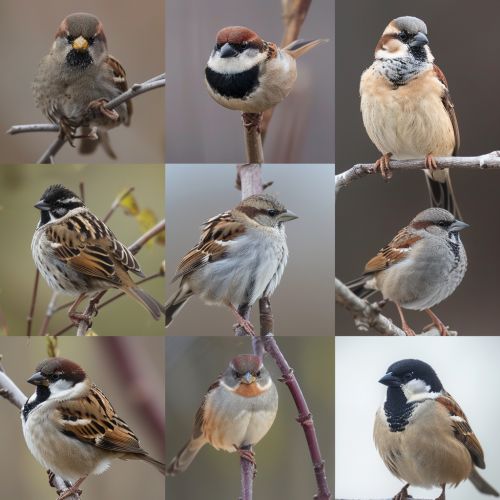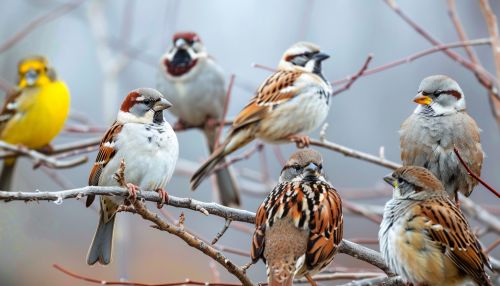Passerellidae
Overview
The family Passerellidae, commonly known as New World sparrows, is a diverse group of small passerine birds found primarily in the Americas. This family encompasses a wide range of species that exhibit significant variation in morphology, behavior, and ecology. Passerellidae is distinguished from other bird families by unique characteristics in their vocalizations, plumage patterns, and habitat preferences.
Taxonomy and Classification
Historical Context
The family Passerellidae was previously included within the Emberizidae family. However, advances in molecular phylogenetics have led to a reclassification, recognizing Passerellidae as a distinct family. This reclassification has been supported by genetic studies that reveal significant evolutionary divergence from other emberizid birds.
Subfamilies and Genera
Passerellidae is divided into several subfamilies and numerous genera. Key subfamilies include:
- Passerellinae: This subfamily includes the typical New World sparrows.
- Arremoninae: Known for their distinctive head patterns and forest-dwelling habits.
- Atlapetinae: Includes species often found in mountainous regions.
Prominent genera within Passerellidae include:
- Zonotrichia: Known for species such as the White-crowned Sparrow.
- Spizella: Includes the Chipping Sparrow and Field Sparrow.
- Melospiza: Encompasses the Song Sparrow and Lincoln's Sparrow.
Morphological Characteristics
Size and Shape
Members of the Passerellidae family typically range from small to medium-sized birds, with body lengths varying from 10 to 20 centimeters. They possess a robust, conical bill adapted for seed-eating, although some species have more specialized bill shapes for their specific dietary needs.
Plumage and Coloration
Passerellidae species exhibit a wide array of plumage patterns and colors. Many species have cryptic coloration that blends with their habitat, while others display bold patterns and bright colors. Sexual dimorphism in plumage is generally minimal, although some species exhibit slight differences between males and females.


Vocalizations and Communication
Song Structure
The vocalizations of Passerellidae are complex and varied. Songs are used primarily for territory defense and mate attraction. Each species has a unique song structure, often consisting of a series of trills, whistles, and buzzes. The White-throated Sparrow (Zonotrichia albicollis), for example, is known for its distinctive "Old Sam Peabody" song.
Learning and Variation
Song learning in Passerellidae is a critical aspect of their behavior. Juveniles learn songs by listening to adult males, often resulting in regional dialects. This cultural transmission of song can lead to significant variation within a species across different geographical areas.
Habitat and Distribution
Geographic Range
Passerellidae species are found throughout the Americas, from the Arctic tundra to the southern tip of South America. They occupy a wide range of habitats, including forests, grasslands, deserts, and wetlands.
Habitat Preferences
Different species within Passerellidae exhibit specific habitat preferences. For instance, the Swamp Sparrow (Melospiza georgiana) is typically found in marshy areas, while the Rufous-collared Sparrow (Zonotrichia capensis) is common in high-altitude grasslands and shrublands.
Feeding Ecology
Diet Composition
The diet of Passerellidae is primarily composed of seeds, insects, and other small invertebrates. Many species exhibit seasonal dietary shifts, consuming more insects during the breeding season to provide protein-rich food for their young.
Foraging Behavior
Passerellidae species employ various foraging strategies. Ground foraging is common, with birds scratching the leaf litter to uncover seeds and insects. Some species, such as the Fox Sparrow (Passerella iliaca), are known for their vigorous double-scratch technique.
Reproduction and Life Cycle
Breeding Season
The breeding season for Passerellidae varies by species and geographic location. In temperate regions, breeding typically occurs in the spring and summer, while tropical species may breed year-round or have multiple breeding peaks.
Nesting and Parental Care
Nests are usually constructed in dense vegetation or on the ground, depending on the species. Both males and females often participate in nest building. Clutch sizes range from 2 to 6 eggs, with incubation periods lasting about 11 to 14 days. Parental care is typically biparental, with both parents feeding and protecting the chicks.
Conservation Status
Threats
Passerellidae species face various threats, including habitat loss, climate change, and predation by invasive species. Agricultural expansion and urban development have led to significant habitat fragmentation, impacting many species' populations.
Conservation Efforts
Conservation efforts for Passerellidae focus on habitat preservation and restoration. Protected areas and wildlife reserves play a crucial role in safeguarding critical habitats. Additionally, research and monitoring programs are essential for understanding population trends and implementing effective conservation strategies.
